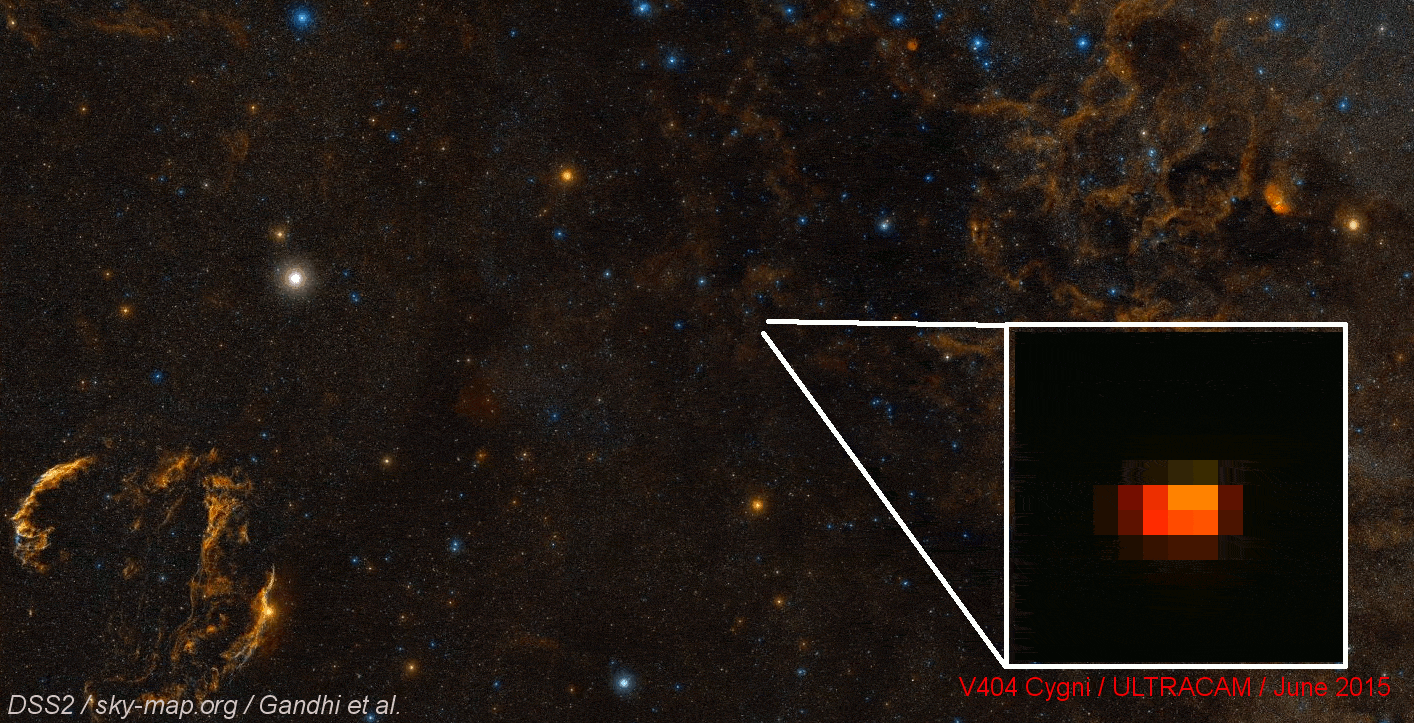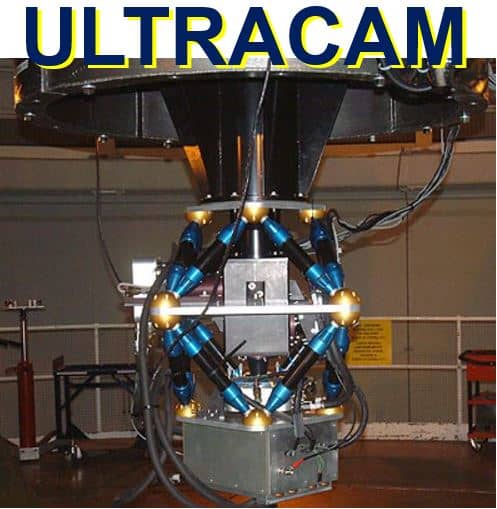Intense red flashes from a violent black hole – V404 Cygni – with the power of 1000 Suns, have been captured by an international team of scientists from the UK, USA, Spain, Czech Republic, India, UAE, Germany and Italy.
The black hole, which is approximately 7,800 light-years from our planet, emitted the spectacular red flashes, which lasted just fractions of a second, as it gobbled up material that its colossal gravity had stripped off an orbiting companion star.
The research team, led by the University of Southampton in England, wrote in the Monthly Notices of the Royal Astronomical Society (citation below) that what they observed was one of the brightest black hole outbursts in recent years.
 An artist’s impression of V404 Cygni devouring a companion star of its material. The event caused jets of matter to burst out from the hole which created incredibly bright red flashes. (Image: ras.org.uk. Credit: L. Calcada/ESO/PA)
An artist’s impression of V404 Cygni devouring a companion star of its material. The event caused jets of matter to burst out from the hole which created incredibly bright red flashes. (Image: ras.org.uk. Credit: L. Calcada/ESO/PA)
Spat out what it could not swallow
In June last year, V404 Cygni – the first definitive black hole to be identified in the Milky Way – became incredibly bright for about two weeks. This can happen when black holes devour material. V404 Cygni was blasting out material it was not able to swallow.
The astronomers and astrophysicists associated the red colour with rapidly-moving jets of matter that were ejected from very close to the black hole.
Lead author, Dr. Poshak Gandhi and colleagues said their study and findings provide new insights into extreme black hole phenomena and how such jets are formed.
 Image of a red flash observed from V404 Cygni by the ULTRACAM fast imager on 26th June, 2015. The ultra-short flashes have the luminosity of about 1,000 times the Sun’s power. In the background image you can see the Cygnus constellation (a region of the sky), with the Cygnus Loop supernova remnant on the left. (Image: ras.org.uk. Credit: DSS2/sky-map.org/Gandhi et al.)
Image of a red flash observed from V404 Cygni by the ULTRACAM fast imager on 26th June, 2015. The ultra-short flashes have the luminosity of about 1,000 times the Sun’s power. In the background image you can see the Cygnus constellation (a region of the sky), with the Cygnus Loop supernova remnant on the left. (Image: ras.org.uk. Credit: DSS2/sky-map.org/Gandhi et al.)
Dr. Gandhi, Associate Professor and STFC Ernest Rutherford Fellow in the University of Southampton’s Astronomy Group, said regarding the region where the red light was being emitted:
“The very high speed tells us that the region where this red light is being emitted must be very compact. Piecing together clues about the colour, speed, and the power of these flashes, we conclude that this light is being emitted from the base of the black hole jet.”
“The origin of these jets is still unknown, although strong magnetic fields are suspected to play a role. Furthermore, these red flashes were found to be strongest at the peak of the black hole’s feeding frenzy.”
“We speculate that when the black hole was being rapidly force-fed by its companion orbiting star, it reacted violently by spewing out some of the material as a fast-moving jet. The duration of these flashing episodes could be related to the switching on and off of the jet, seen for the first time in detail.”
Team had to react rapidly
The scientists knew these bright black hole ‘outbursts’ are extremely rare and unpredictable, which meant that they had extremely little time to react. The last time V404 Cygni erupted was in 1989.
V404 Cygni was extraordinarily bright in June last year, and provided an ideal opportunity for such work. Most outbursts are fairly dim, making it hard to study them.
 The ULTRACAM, ultra-fast, triple-beam CCD camera was used to observe the black hole outburst. The instrument was built by a consortium involving the Universities of Sheffield, Southampton and the UKATC, Edinburgh. (Image: ing.iac.es)
The ULTRACAM, ultra-fast, triple-beam CCD camera was used to observe the black hole outburst. The instrument was built by a consortium involving the Universities of Sheffield, Southampton and the UKATC, Edinburgh. (Image: ing.iac.es)
Each flash was unimaginably intense, with the equivalent to power about one thousand Suns. They also lasted a very short time – some of them less than 1/40th of a second, which is about ten times faster than the blink of an eye.
To be able to observe these amazing events, state-of-the-art technology is required. The researchers used the ULTRACAM fast imaging camera that is mounted on the William Herschel Telescope in La Palma on the Canary Islands.
Co-creator of ULTRACAM, Professor Vik Dhillon, who works at the University of Sheffield, said regarding the camera:
“ULTRACAM is unique in that it can operate at very high speed, capturing high frame-rate ‘movies’ of astronomical targets, in three colours simultaneously. This allowed us to ascertain the red colour of these flashes of light from V404 Cygni”
Astronomers globally keen to work together
The authors said that the event in June 2015 has greatly motivated astronomers globally to coordinate international efforts to observe future outbursts.
Dr Gandhi said:
“Their short durations, and strong emissions across the entire electromagnetic spectrum, require close communication, sharing of data, and collaborative efforts amongst astronomers. These observations can be a real challenge, especially when attempting simultaneous observations from ground-based telescopes and space satellites.”
What are black holes?
According to the European Space Agency, black holes are the most mysterious objects in the Universe. They have no surface, like a star or planet has. Instead, a black hole is a region of space where matter has collapsed in on itself.
This calamitous collapse results in a colossal amount of mass being concentrated in a very tiny area. The gravitational pull of a black hole is so great that not even light can escape.
We know black holes exist, even though we cannot ‘see’ them. We know they affect nearby galaxies, stars and dust. Several black holes are surrounded by discs of material, which become super-hot and give off X-rays.
Black holes come in many sizes, ranging from just a few times more massive than our Sun, to super-massive black holes which are unimaginably huge and power active galaxies and ancient ones (quasars).
Citation: “Furiously Fast and Red: Sub-second Optical Flaring in V404 Cyg during the 2015 Outburst Peak,” P. Gandhi, D.J. Walton, S.P. Littlefair, L.K. Hardy, T. Shahbaz, D.M. Terndrup, J. Tomsick, V.S. Dhillon, T.R. Marsh, A.W. Shaw, D. Altamirano, M.D. Caballero-Garcia, J. Casares, D.M. Russell, J.V. Hernández Santisteban, P. Casella, A.J. Castro-Tirado, P.A. Charles, Y. Dallilar, S. Eikenberry, R.P. Fender, M. Pahari, F. Rahoui, R.I. Hynes, C. Knigge, E. Kuulkers, K. Mooley and T. Mu noz-Darias. Monthly Notices of the Royal Astronomical Society. 14 March 2016. DOI: 10.1093/mnras/stw571.
Video – V404 Cygni devouring companion star
This NASA video, published on 30th June, 2015, is an animation that shows the onset of a rare X-ray outburst from V404 Cygni. A stream of gas from a companion star flows towards the black hole. Instead of spiraling towards the black hole, the gas builds up in an accretion disk around it.
